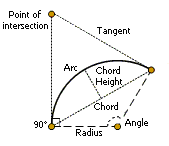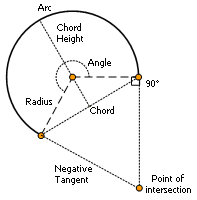Available with Standard or Advanced license.
When you enter curves for a line or a polygon, you need to provide at least two curve parameters to create the curve segment. Occasionally, you might want to know what all the parameters are or calculate missing parameters.
The Curve Calculator lets you determine the complete characteristics of a curve from two known parameters. This illustration shows the parts of a curve:

- Chord—Also referred to as the chord distance, the straight line distance between the endpoints of the curve.
- Angle—The angle formed between the endpoints of the curve and the center point.
- Arc—The length along the curve.
- Radius—The length from the center point to the curve.
- Tangent—The distance between the endpoint and the point of intersection. The point of intersection is determined by intersecting a perpendicular line from each of the endpoints of the curve.
- Chord height—Also referred to as the arc height, this is the distance between the curve and the chord segment.
There are several cases where the curve calculated is based on an angle greater than 180°:
- The angle is greater than 180°.
- The chord distance is greater than the arc length.

In these cases, the tangent distance is negative and represents the point of intersection on the opposite side of the curve.
- Click Curve Calculator
 on the COGO toolbar.
on the COGO toolbar.
- Click the drop-down arrows and choose two parameters to determine the curve.
- Type the appropriate values for the parameters. Angles are reported in the current direction type and units. Distances are always reported in the units of the map's spatial reference.
- Click Calculate.
The curve is calculated and shown in the list below the Calculate button.